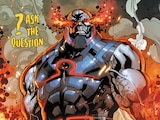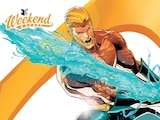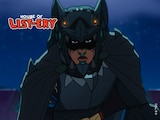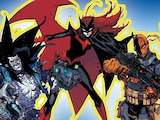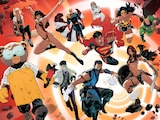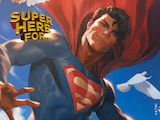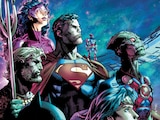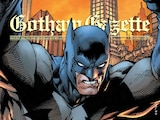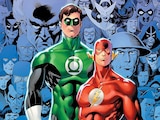In 2015, writer Geoff Johns and artist Jason Fabok teamed for the epic Justice League story “The Darkseid War,” which saw Batman take a seat on Metron’s Mobius Chair with the Dark Knight using his temporary omniscience to ask the Joker’s real name.
The answer shocked Batman, but we didn’t know why until 2016’s DC Universe: Rebirth #1, which revealed that the response to Bruce Wayne’s query was that there were, in fact, three Jokers. What that meant and how that was even possible has remained a mystery…until now. Four very eventful years later, this week sees the release of Batman: Three Jokers #1 by Johns and Fabok, which stars Batman, Batgirl and the Red Hood—three characters who have each been damaged by the Joker in extremely significant ways—confronting both the puzzle of the Joker’s very existence and their own demons inflicted by the Clown Prince of Crime.
DC Nation spoke with Johns in advance of the first issue’s release to learn more about the origin of the series, go deeper into the very personal stakes for the three protagonists, and gain some insight on what exactly it means for there to be Three Jokers. Check back next month for an interview with Jason Fabok about illustrating this unique and complex story.

Geoff, this series has been a long time in the making, and it’s finally coming out. How excited are you for readers to finally see it? What are you most excited for them to discover?
I’ve said this before, but if Jay and I were going to do a Batman/Joker story, we wanted to make it the best possible Batman/Joker story we could do. There have been so many that have been done so well. We wanted to do something that was emotional and surprising and serious, and really looked at the Joker and his effect on the lives of those he’s harmed over the years. The book is about scars, wounds and healing—healing right and healing wrong.
It’s been a pleasure working with Jay on this. Jay and I connect in a way that doesn’t happen often. It’s an amazing body of illustrated storytelling that Jay has done. The complexity of storytelling, emotion, mood, tone, everything in this book, is just A+. Jay knocked it out of the park, and he tapped into something that is so rare. I’m excited for people to see it.
When you’re dealing with the Joker, you want to do something new. You want to do something that’s both true to the character, and also showing a different layer and different viewpoint. He’s one of the greatest characters in all of comics, and he’s been interpreted so many ways, so well, in so many mediums.

What did you see in the Joker and his relationship with Batman that led to Three Jokers taking shape?
It wasn’t just the relationship between the Joker and Bruce, but the Joker and Bruce, and Barbara (Gordon), and Jason (Todd). For me, the touchstones in the Joker’s interactions with Batman have always resulted in major tragedies that have left deep wounds that reverberate through these characters for years to come—from Batman’s first encounter with the Joker in Batman #1 to The Killing Joke and Death in the Family. Those three events are where we’re drawing our inspiration from.
Just because they’ve continued doesn’t mean those wounds aren’t still there. The Joker knows this, and he’s on a mission that will become very clear. In Barbara’s case, I think there’s still a struggle, physically—it might be in her own mind. She pushes herself harder than she needs to, just to make sure she’s better. She wants to be the best she’s been. But emotionally, I think it’s made her stronger. More focused. I find Barbara Gordon to be a fascinating, wonderful, strong and inspiring character because of what she’s gone through and what she does.
On the other hand, you have Jason, who appears to have no physical remnants of this attack, but he struggles more emotionally than Barbara does, I think. He’s incredibly damaged from the events that have occurred—and he wasn’t exactly on the most steady ground beforehand, after all. Barbara’s support group is pretty phenomenal, and Jason doesn’t allow a support group to exist around him in any real way.
These three characters and their pain, how they process and deal with it, is what the book is focused on. Some emotional and physical scars don’t heal. This is a story of how the Joker takes advantage of that.

Batman has had 80 years of trauma inflicted by the Joker. How personal is this story to him?
It’s incredibly personal. The story’s really about exploring that personal connection between Bruce and Joker. Bruce’s pain comes from the Joker’s totality—what he’s done to Barbara, what he’s done to Jason, what he’s done to so many people. Bruce has a very specific struggle with that, and what to do about it. There are things about it that we’ll come to understand in a slightly different light.
Jay and I wanted to take a look at the relationship between Bruce and the Joker, and show different sides to it, and a different part of it than we’ve ever seen before. If we’re going to tell a story about Batman and the Joker, what’s it going to be about? I don’t want it to just be about the Joker throwing everything he’s got again at the Batman family because he’s done a lot of damage already. What’s new—and not just new in a plot-driven way, but emotionally? What layers, what revelations can we expose and confront that will reflect on things that we all deal with, too? The best superhero stories are obviously reflective of everything we deal with emotionally. I think tapping into how you heal from a wound, right and wrong, is something that’s been really compelling and therapeutic.

How do you define the titular Three Jokers?
The three Jokers are a very real thing. We’re not dealing with multiverses or different dimensions or anything like that. It’s all very real world, very grounded.
The simple core of the story is that Bruce, Barbara and Jason are investigating, with vested interest, why there appear to be three Jokers in operation. Who are they? What are they? Is this true? That’s the central mystery that then spurs them off into everything else.
The Joker has been around for decades and interpreted in a myriad of ways. What did you learn about the character when writing Three Jokers?
He’s a very frightening character. In a lot of ways. I understand a lot of the motivations of the villains I’ve written before—Sinestro, Black Adam, Captain Cold. I understand those characters and why they might choose to do what they do.
There are very few characters that are, to me, as irredeemable as the Joker. There is nothing in him that is good. It’s a dark, dark place to go. Which, as a writer, is a great, challenging place to be.
Batman: Three Jokers #1, written by Geoff Johns and illustrated by Jason Fabok and Brad Anderson, is on sale today in print and as a digital comic.

